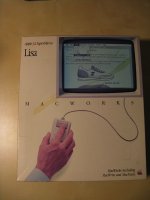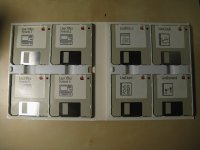Cosmo
Well-known member
Kind of long story, i'm trying to make it short… a friend of mine (JuhaniL) told about a guy who used to have an company close by where our company used to be located (1993-2010) and who had an Apple Lisa. So i investigated and find the guy, by really a good luck with using some google-search. Found out that he had given the Lisa away for some Apple retailer about 10-15 years ago but said he had some other old things in his garage were all these came from. So, got these today:
(they were in a cold car for almost an half a day, so i keep them in normal temp. for an 24 hours before booting them up. Just in case).
- Apple ][ europlus (with Disk ][ interface card), works, all keys are there, not much yellowing (different plastics?) dates 01/83. It has an another card on it, but it doesn't look PAL-encoder card to me, unless it's an some kind of local hack..
- Apple Disk ][ -drive
- Lisa MacWorks (boxed with manual but missing the MacWrite and MacPaint manuals)
- Lisa Office System (Release 3) (boxed)
- Apple Lisa keyboard (Finnish) quite yellowed but all keys are there and they work, missing shortcuts paper under the keyboard.
- MacGolf (Game, 1985, with all inserts and paper works)
- Apple Works (disks set, 3x 5.25" and 2x3.5")
- Macintosh IIsi (not yet booted, but looks stock to me with the card riser)
- Outbound Laptop 125 (Macintosh clone - this is really neat!)
- Apple PC 5.25" drive - A9M0110 (never used? sealed cables)
- Apple extended keyboard (no yellowing)
- Apple Keyboard II (no yellowing)
- Geopot telecom adapter II
- Apple desktop bus mouse
- Graphics tablet (non Apple)
+ bunch of misc. cables
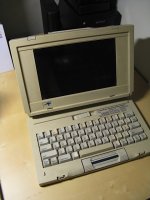
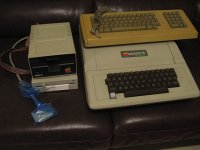
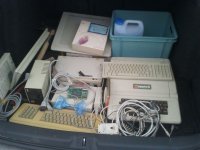
(they were in a cold car for almost an half a day, so i keep them in normal temp. for an 24 hours before booting them up. Just in case).
- Apple ][ europlus (with Disk ][ interface card), works, all keys are there, not much yellowing (different plastics?) dates 01/83. It has an another card on it, but it doesn't look PAL-encoder card to me, unless it's an some kind of local hack..
- Apple Disk ][ -drive
- Lisa MacWorks (boxed with manual but missing the MacWrite and MacPaint manuals)
- Lisa Office System (Release 3) (boxed)
- Apple Lisa keyboard (Finnish) quite yellowed but all keys are there and they work, missing shortcuts paper under the keyboard.
- MacGolf (Game, 1985, with all inserts and paper works)
- Apple Works (disks set, 3x 5.25" and 2x3.5")
- Macintosh IIsi (not yet booted, but looks stock to me with the card riser)
- Outbound Laptop 125 (Macintosh clone - this is really neat!)
- Apple PC 5.25" drive - A9M0110 (never used? sealed cables)
- Apple extended keyboard (no yellowing)
- Apple Keyboard II (no yellowing)
- Geopot telecom adapter II
- Apple desktop bus mouse
- Graphics tablet (non Apple)
+ bunch of misc. cables



Last edited by a moderator:


